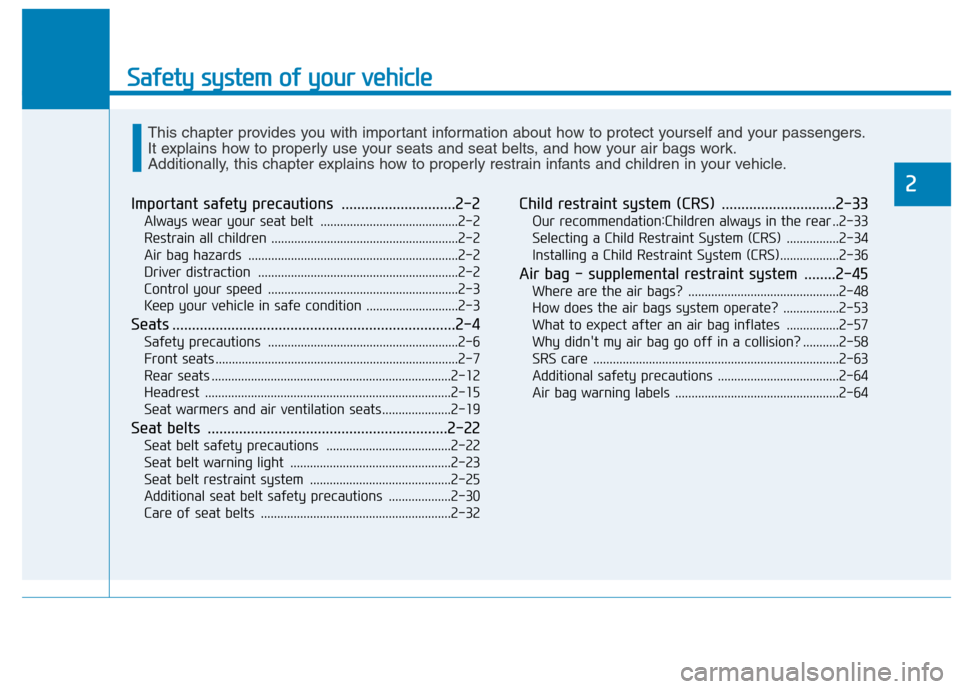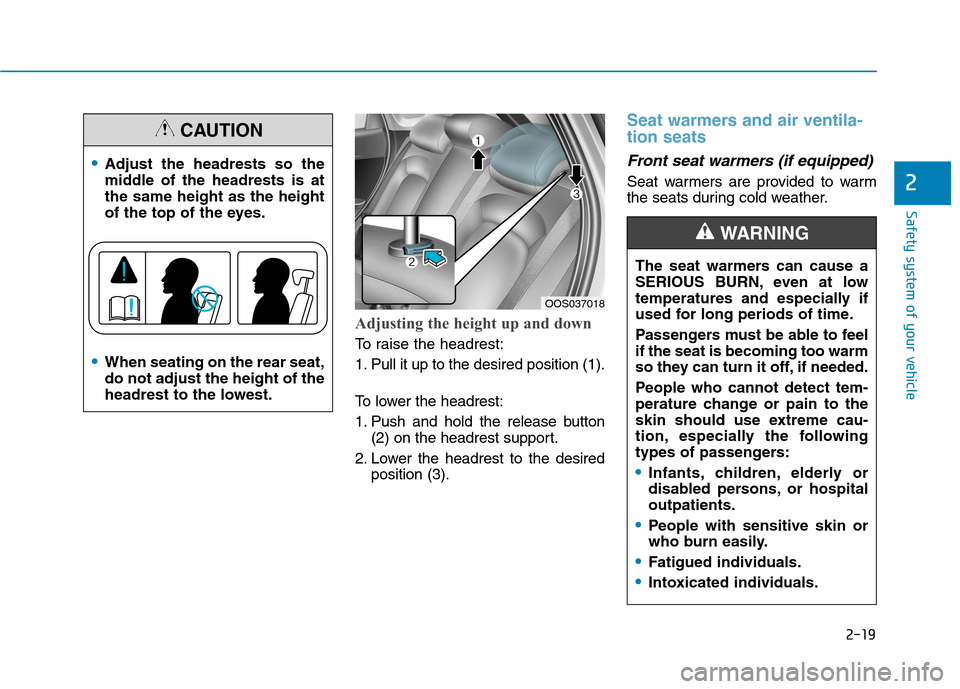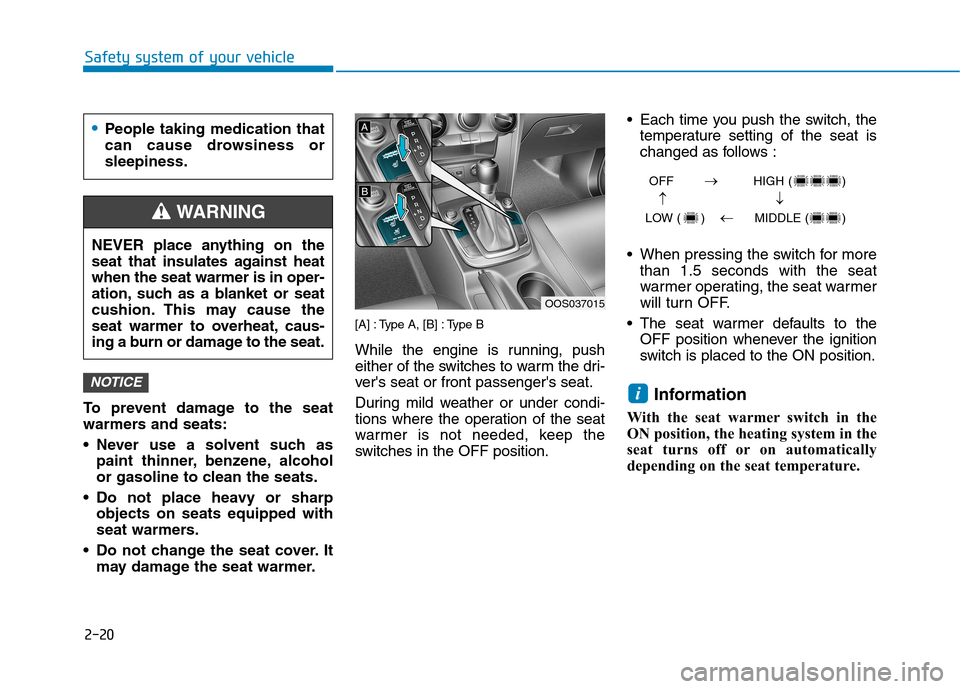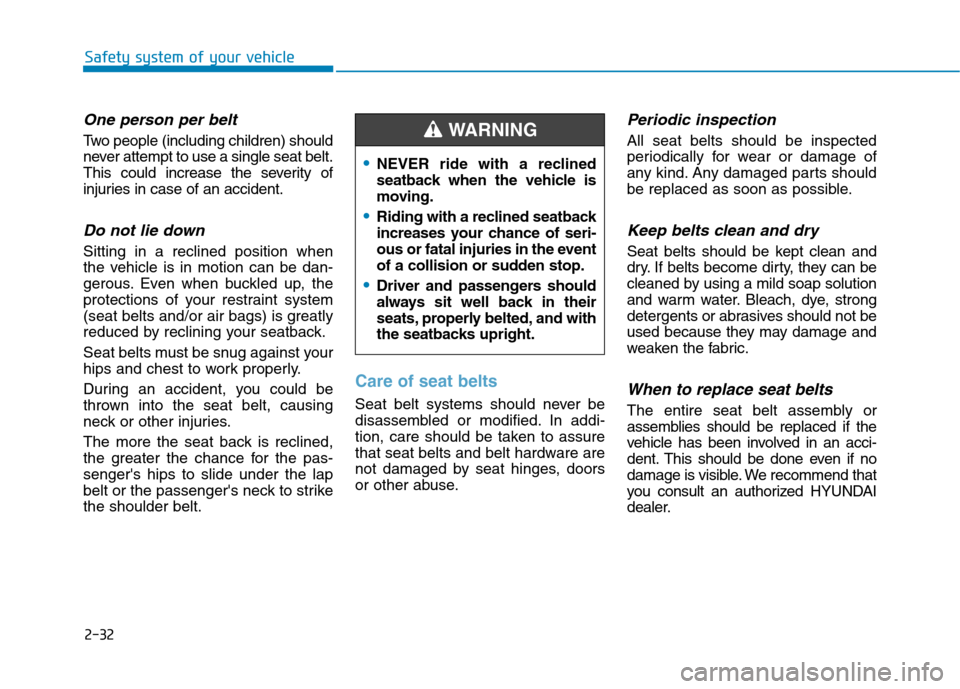2018 Hyundai Kona seats warm up
[x] Cancel search: seats warm upPage 20 of 523

Safety system of your vehicle
2
Important safety precautions .............................2-2Always wear your seat belt ..........................................2-2
Restrain all children .........................................................2-2
Air bag hazards ................................................................2-2
Driver distraction .............................................................2-2
Control your speed ..........................................................2-3
Keep your vehicle in safe condition ............................2-3
Seats ........................................................................2-4 Safety precautions ..........................................................2-6
Front seats ..........................................................................2-7
Rear seats .........................................................................2-12
Headrest ...........................................................................2-15
Seat warmers and air ventilation seats.....................2-19
Seat belts .............................................................2-22 Seat belt safety precautions ......................................2-22
Seat belt warning light .................................................2-23
Seat belt restraint system ...........................................2-25
Additional seat belt safety precautions ...................2-30
Care of seat belts ..........................................................2-32 Child restraint system (CRS) .............................2-33
Our recommendation:Children always in the rear ..2-33
Selecting a Child Restraint System (CRS) ................2-34
Installing a Child Restraint System (CRS)..................2-36
Air bag - supplemental restraint system ........2-45 Where are the air bags? ..............................................2-48
How does the air bags system operate? .................2-53
What to expect after an air bag inflates ................2-57
Why didn't my air bag go off in a collision? ...........2-58
SRS care ...........................................................................2-63
Additional safety precautions .....................................2-64
Air bag warning labels ..................................................2-64
This chapter provides you with important information about how to protect yourself and your passengers.
It explains how to properly use your seats and seat belts, and how your air bags work.
Additionally, this chapter explains how to properly restrain infants and children in your vehicle.
Page 38 of 523

2-19
Safety system of your vehicle
2
Adjusting the height up and down
To raise the headrest:
1. Pull it up to the desired position (1).
To lower the headrest:
1. Push and hold the release button(2) on the headrest support.
2. Lower the headrest to the desired position (3).
Seat warmers and air ventila- tion seats
Front seat warmers (if equipped)
Seat warmers are provided to warm
the seats during cold weather.
The seat warmers can cause a
SERIOUS BURN, even at low
temperatures and especially if
used for long periods of time.
Passengers must be able to feel if the seat is becoming too warm
so they can turn it off, if needed.
People who cannot detect tem-
perature change or pain to the
skin should use extreme cau-
tion, especially the following
types of passengers:
Infants, children, elderly or
disabled persons, or hospitaloutpatients.
People with sensitive skin or
who burn easily.
Fatigued individuals.
Intoxicated individuals.
WARNING
OOS037018
Adjust the headrests so the
middle of the headrests is atthe same height as the height
of the top of the eyes.
When seating on the rear seat, do not adjust the height of the
headrest to the lowest.
CAUTION
Page 39 of 523

2-20
Safety system of your vehicle
To prevent damage to the seat
warmers and seats:
Never use a solvent such aspaint thinner, benzene, alcohol
or gasoline to clean the seats.
Do not place heavy or sharp objects on seats equipped with
seat warmers.
Do not change the seat cover. It may damage the seat warmer. [A] : Type A, [B] : Type B
While the engine is running, push
either of the switches to warm the dri-
ver's seat or front passenger's seat.
During mild weather or under condi-
tions where the operation of the seat
warmer is not needed, keep the
switches in the OFF position. Each time you push the switch, the
temperature setting of the seat is
changed as follows :
When pressing the switch for more than 1.5 seconds with the seat
warmer operating, the seat warmer
will turn OFF.
The seat warmer defaults to the OFF position whenever the ignition
switch is placed to the ON position.
Information
With the seat warmer switch in the
ON position, the heating system in the
seat turns off or on automatically
depending on the seat temperature.iNOTICE
OOS037015 OFF HIGH ( )
LOW ( ) MIDDLE ( )
��
�
�
People taking medication that
can cause drowsiness orsleepiness.
NEVER place anything on the
seat that insulates against heatwhen the seat warmer is in oper-
ation, such as a blanket or seat
cushion. This may cause the
seat warmer to overheat, caus-
ing a burn or damage to the seat.
WARNING
Page 51 of 523

2-32
Safety system of your vehicle
One person per belt
Two people (including children) should
never attempt to use a single seat belt.
This could increase the severity of
injuries in case of an accident.
Do not lie down
Sitting in a reclined position when
the vehicle is in motion can be dan-
gerous. Even when buckled up, the
protections of your restraint system
(seat belts and/or air bags) is greatly
reduced by reclining your seatback.
Seat belts must be snug against your
hips and chest to work properly.
During an accident, you could be
thrown into the seat belt, causing
neck or other injuries.
The more the seat back is reclined,
the greater the chance for the pas-senger's hips to slide under the lap
belt or the passenger's neck to strikethe shoulder belt.
Care of seat belts
Seat belt systems should never be
disassembled or modified. In addi-
tion, care should be taken to assure
that seat belts and belt hardware are
not damaged by seat hinges, doors
or other abuse.
Periodic inspection
All seat belts should be inspected
periodically for wear or damage of
any kind. Any damaged parts should
be replaced as soon as possible.
Keep belts clean and dry
Seat belts should be kept clean and
dry. If belts become dirty, they can be
cleaned by using a mild soap solution
and warm water. Bleach, dye, strong
detergents or abrasives should not be
used because they may damage and
weaken the fabric.
When to replace seat belts
The entire seat belt assembly or
assemblies should be replaced if the
vehicle has been involved in an acci-
dent. This should be done even if no
damage is visible. We recommend that
you consult an authorized HYUNDAI
dealer.
NEVER ride with a reclined
seatback when the vehicle is
moving.
Riding with a reclined seatback
increases your chance of seri-
ous or fatal injuries in the event
of a collision or sudden stop.
Driver and passengers should
always sit well back in their
seats, properly belted, and with
the seatbacks upright.
WARNING
Page 521 of 523

I-10Safety messages..............................................................F-5
Scheduled maintenance services ....................................7-7
Seat belt warning light
Driver's seat ..............................................................2-23
Front passenger's seat ..............................................2-24
Rear passenger's seat ................................................2-25
Seat belts .......................................................................2-22 Seat belt safety precautions......................................2-22
Seat belt warning light .............................................2-23
Rear center seat belt .................................................2-27
Lap/shoulder belt......................................................2-25
Seat belt restraint system .........................................2-25
Height adjustment ....................................................2-26
Pre-tensioner seat belt ..............................................2-28
Additional seat belt safety precautions ....................2-30
Seat belt use during pregnancy ................................2-30
Seat belt use and children ........................................2-30
Seat belt use and injured people ..............................2-31
One person per belt ..................................................2-32
Do not lie down........................................................2-32
Care of seat belts ......................................................2-32
Periodic inspection ...................................................2-32
Keep belts clean and dry ..........................................2-32
When to replace seat belts .......................................2-32
Seat warmers.................................................................2-19
Seats ................................................................................2-4 Safety precautions ......................................................2-6 Front seat adjustment .................................................2-7
Rear seat adjustment ................................................2-12
Headrest....................................................................2-15
Front seat warmers ...................................................2-19
Shift lights.....................................................................3-42
Side air bags .................................................................2-51
Smart key ........................................................................3-6
Locking ......................................................................3-6
Unlocking ...................................................................3-7
Tailgate unlocking ......................................................3-7
Mechanical key ..........................................................3-8
Battery replacement ...................................................3-9
Smooth cornering .........................................................5-97
Snow tires ...................................................................5-100
Spare tire
Compact spare tire replacement...............................7-41
Special driving conditions ............................................5-96
Hazardous driving conditions ..................................5-96
Rocking the vehicle..................................................5-96
Smooth cornering .....................................................5-97
Driving at night ........................................................5-97
Driving in the rain ....................................................5-97
Driving in flooded areas ..........................................5-98
Highway driving ......................................................5-98
Speed limit control system ...........................................5-88
Speed sensing door lock ...............................................3-15
Speedometer .................................................................3-38
Starting difficulties, see engine will not start .................6-4
Index
S